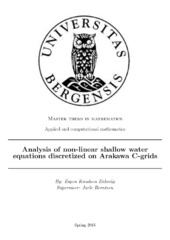| dc.description.abstract | To model the behaviour of flow and waves in three dimensions, one may use the Navier-Stokes equations. These equations leads to the shallow water equations, when the depth is much smaller than the wavelength. The shallow water equations are depth-integrated Navier-Stokes equations, and they depict in general a two dimensional wave which can not vary with the depth. Storm surges and tidal waves are described by the shallow water equations. When we want to make a forecast of these waves, it is beneficial to use shallow water equations discretized on a Arakawa C-grid. Fourier methods have been used to study the stability of the solutions for constant depths. In this master thesis, we will study the stability of numerical methods for solving the shallow water equations, investigating the eigenvalues of the propagation matrices of a few grid cells. The effects of variable depths and non-linear terms are addressed. For the constant depths cases, the eigenvalues are purely imaginary. In the non-linear cases, the eigenvalues may have non- zero real components, which may give growth or damping of the solutions. By building on the two-cell case, the three- and the four-cell cases are explored in detail. With the three- cell case we introduce the non-linear term, which have the potential to change the stability. For this case, we show a skew-symmetric form for the non-linear shallow water equations by combining the flux and advective forms in the three cell case. This form does not work on variable depths. The four-cell case is discussed to great extent, as it is set up differently than the two- and three-cell case. The behaviour of the eigenvalues have been important to study the stability of the cases. To understand the modes of the cases, the eigenvectors have been interpreted. The condition of skew-symmetry for the non- linear variable depths cases might be a too strong restriction, as the modes do not disperse to different frequencies. This is contrary to the behaviour of real waves, where we have interaction between different modes. | en_US |
